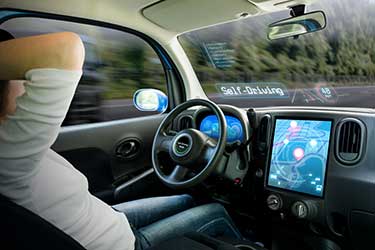
Written by Kayla Jane Barrie Updated on Dec 10, 2025 5 mins read

Have you thought about the idea of being the co-pilot of a computer while sitting in the driver's seat of your car? Perhaps it is because we are enchanted with technology or looking for solutions to traffic congestion, commuting, road rage, the environment, or even the economy. Are self-driving cars the answer? Should we let AI take the front seat in our day-to-day life? Read on to learn more about self-driving cars in Canada.
When people think about fully automated vehicles, they get a vision of reading the newspaper while their vehicle gets them to their destination. Not so fast. Think less like the Jetsons and more like a train conductor.
According to the Ontario Ministry of Transportation, Autonomous vehicles are "capable of detecting the surrounding environment using artificial intelligence, sensors and global positioning system coordinates." This means drivers will still be required to pay attention and will have the ability to override the automated when necessary, similar to a train conductor.
There is, and will be, varying levels of automation. One can expect new vehicles to roll out with greater automation capabilities over the next decade or so. There are already vehicles on the road with automated features such as cruise control, parking assist, and brake assist to name a few.
The science behind a self-driving car lies behind the AI. Radar, cameras and LiDAR (light detection and ranging) work together to be the eyes on the road to detect objects distance and speed. There are five levels of self-driving cars :
What you can expect in the future is an incremental shift in control from the driver to the car's computer system, with the goal eventually to be level 5 – with your vehicle having complete control over your driving experience.
It is not only tech companies that are researching and creating driverless vehicles for our roads. Automotive companies are also getting involved with new vehicle features and fully autonomous options. These companies are leading the way in real-world testing :
This company began as the Google Self-Driving Car Project in 2009. They have driven 32 million kilometres (real world) and have created their sensors from the ground up. In 2015, they created entirely self-driving cars with custom steering and braking – without a steering wheel or pedals, that passed a test drive with a blind man. Now, they are operating fully driverless rides within Waymo One in Arizona, California and Michigan.
Elon Musk's Tesla is one of the few manufacturers not using LiDAR – they created their unique version. Tesla uses ultrasonic, radar, and 2D camera devices to enable the car's autonomous abilities. They have more than 600,000 vehicles on the global road and are continuously researching ways to have fully driverless cars on the road.
GM's 111 years of experience in car manufacturing give them vehicle experience over tech companies. They claim the world's second-largest fleet with 180 driverless vehicles undergoing testing. Cruise received a California DMV permit to remove human backup drivers and create cars without gasoline.
These are only the top three companies gearing up for driverless vehicles. Apple, BMW, Audio, Lyft, Uber and Volkswagen are a few honourable mentions.

In Canada, the only province to allow driverless vehicles is Ontario. As of January 2019, driverless cars are allowed on Ontario roads. Participants in Ontario's automated vehicle pilot program can test driverless cars on public roadways but under strict conditions. BlackBerry's QNX, Magna, Uber and the University of Waterloo are currently testing ten vehicles, but are not yet using fully driverless, yet. When the cars are available, the government says they will be allowed on Ontario roads.
Automated cars will undoubtedly have a significant impact on the insurance industry. It will change how premiums are determined, the types of coverage offered, and how much you will pay. However, the exact impact self-driving cars will have on car insurance quotes is still unclear.
Many vehicles now come with semi-automated safety features. However, the question of a policy being impacted by a driverless car is undecided. Once these vehicles become industry standard, automation levels will determine pricing to reflect the level of automation. This could remove traditional risk factors such as driving history and age.
Another concern is who is to blame for an accident - does liability still rest in the driver's hands, or does the manufacturer take the blame? Liability laws will evolve to ensure autonomous vehicle advances are not stalled.
In general, you can expect that higher degrees of autonomy will improve safety profiles, translating into a lower risk of accidents and, therefore, lower rates.
A recent survey found that 46% of consumers do not trust self-driving vehicles. There have been accidents from Tesla and Uber, which have resulted in fatal accidents on public roads.
As technology improves, so will the safety of driverless vehicles. Developers of these vehicles say they can reduce 40,000 fatalities every year. Until then, no amount of data can replace safe driving behaviours from a driver who is focused and aware of their safety and those around them.
Here is a look at the pros and cons of driverless vehicles :
On average, a self-driving car could generate up to 100 gigabytes of data per second. Where will that data go?
There are some concerns about how self-driving cars will affect privacy. Most models will track sensitive data which includes real-time location information, fingerprints, and eye scans. There are concerns that this data can be sold to third parties for advertising – over time the technology will build a profile for you that fits the types of places you shop and eat at and paid ads will take place over organic searches.
Aggregate data would be used to manage traffic and reduce congestion. Non-sensitive data would track how the vehicle is performing including gas mileage. Non-sensitive data would benefit consumers because manufacturers could use the information to improve safety or performance issues.
As driverless cars improve their technology, cyber security will play a role in how people adopt the cars.
Ontario is the only province that allows for driverless vehicles to be tested on public roads. There must be a passenger in the car or a remote operator monitoring the car.
If vehicles are powered electronically and paired with a clean electricity grid, transportation emissions will be lower. If ride shares begin to use driverless cars, it could enable more shared rides, reducing emissions.
Autonomous cars can see what is on the road because of radar, cameras, and LiDAR. These three features work together to provide the robot with superhuman vision by providing the car with visuals of its surroundings to help detect 3D shapes and objects' distance and speed.
Not all self-driving cars will be electric, and some will be gas hybrids. Ford is planning on launching autonomous vehicles by 2022 and will offer hybrid electrics. However, GM is aiming for "Zero emissions. Zero Crashes. Zero congestion." Tesla is also focusing on all-electric programs for their fully self-driving cars.
As a technological advancement, self-driving cars may be as disruptive a technology as Uber has been to the taxi industry. There will be some bumps in the road, and there will be some pushback.
However, whether you are in favour of self-driving or fully autonomous cars, they are here to stay. They will only become a more prominent part of the auto industry as the technology improves with further testing.
The Ontario government's 10-year pilot program is an excellent start to explore the financial, social and environmental impacts of automated vehicles. You will have to stay tuned to truly see how self-driving cars will change the way we drive.
| Categories | Industry News |
|---|---|
| Tags | Tips and Advice |
Read our insurance blog to get helpful tips, information and news.
Has your car been totalled in an accident? Is your car a write off? Learn about vehicle write offs for a total loss insurance claim.
Get the facts on Toronto's auto theft problem. We break down the data, reveal the most-stolen vehicles (including the Honda CR-V and Lexus RX 350), and show which neighbourhoods are most affected.
Dive into the world of auto theft with our blog on the most stolen cars in Canada. See the most stolen cars across Canada, including provincial lists for Ontario and Quebec, and learn how high-risk models can affect your car insurance premiums.
Drive safe this winter! Check out these tips for driving in snowy and icy conditions in Ontario. Get other helpful info and FAQs on winter driving.